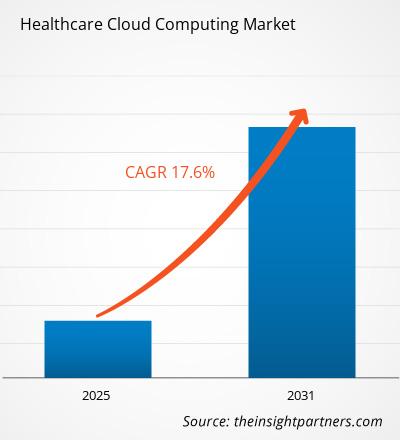من المتوقع أن يسجل سوق الحوسبة السحابية للرعاية الصحية معدل نمو سنوي مركب بنسبة 17.60٪ من عام 2025 إلى عام 2031، مع توسع حجم السوق من 55.48 مليار دولار أمريكي في عام 2024 إلى 172.59 مليار دولار أمريكي بحلول عام 2031.
يُصنّف التقرير حسب التطبيق (نظام المعلومات السريرية، نظام المعلومات غير السريرية)، ويُحلل السوق بناءً على الخدمات (البرمجيات كخدمة، والبنية التحتية كخدمة، والمنصة كخدمة). كما يُحلل السوق حسب النشر (السحابة الخاصة، السحابة العامة) والمستخدمين النهائيين في القطاع (مقدمو الرعاية الصحية، ودافعو تكاليف الرعاية الصحية). ويُقدّم تحليلاً شاملاً على المستويات العالمية والإقليمية والقُطرية لكل من هذه القطاعات الرئيسية.
يتضمن التقرير حجم السوق وتوقعاته لجميع القطاعات، مع عرض القيم بالدولار الأمريكي. كما يُقدّم إحصاءات رئيسية حول الوضع الحالي للسوق لدى أبرز الجهات الفاعلة، بالإضافة إلى رؤى حول اتجاهات السوق السائدة والفرص الناشئة.
غرض التقرير
يهدف تقرير سوق الحوسبة السحابية للرعاية الصحية الصادر عن شركة إنسايت بارتنرز إلى وصف المشهد الحالي والنمو المستقبلي، وأهم العوامل المحفزة، والتحديات، والفرص المتاحة. وسيوفر هذا التقرير رؤى ثاقبة لمختلف أصحاب المصلحة في قطاع الأعمال، مثل:
- مزودي/مصنعي التكنولوجيا: لفهم ديناميكيات السوق المتطورة ومعرفة فرص النمو المحتملة، وتمكينهم من اتخاذ قرارات استراتيجية مستنيرة.
- المستثمرون: لإجراء تحليل شامل للاتجاهات فيما يتعلق بمعدل نمو السوق، والتوقعات المالية للسوق، والفرص الموجودة عبر سلسلة القيمة.
- الهيئات التنظيمية: لتنظيم السياسات ومراقبة الأنشطة في السوق بهدف تقليل الانتهاكات والحفاظ على ثقة المستثمرين ودعم سلامة السوق واستقرارها.
تجزئة سوق الحوسبة السحابية للرعاية الصحية
طلب
- نظام المعلومات السريرية
- نظام المعلومات غير السريرية
خدمة
- البرمجيات كخدمة
- البنية التحتية كخدمة
- المنصة كخدمة
النشر
- سحابة خاصة
- السحابة العامة
المستخدمون النهائيون
- مقدمي الرعاية الصحية
- دافعو الرعاية الصحية
ستحصل على تخصيص لأي تقرير - مجانًا - بما في ذلك أجزاء من هذا التقرير، أو تحليل على مستوى الدولة، وحزمة بيانات Excel، بالإضافة إلى الاستفادة من العروض والخصومات الرائعة للشركات الناشئة والجامعات
سوق الحوسبة السحابية للرعاية الصحية: رؤى استراتيجية

-
احصل على أهم اتجاهات السوق الرئيسية لهذا التقرير.ستتضمن هذه العينة المجانية تحليل البيانات، بدءًا من اتجاهات السوق وحتى التقديرات والتوقعات.
عوامل نمو سوق الحوسبة السحابية للرعاية الصحية
- تمكين المرضى: صعود حلول الرعاية الصحية عن بُعد
- تبسيط العمليات: تقنية الحوسبة السحابية تعزز كفاءة الرعاية الصحية
- القرارات القائمة على البيانات: الذكاء الاصطناعي يعزز رعاية المرضى في السحابة
اتجاهات مستقبل سوق الحوسبة السحابية للرعاية الصحية
- حلول الرعاية الصحية السحابية لرعاية المرضى بشكل أفضل
- تحويل الصحة: الابتكارات السحابية تعزز الكفاءة في الرعاية الصحية
- تمكين مقدمي الخدمات: صعود الحوسبة السحابية في خدمات الرعاية الصحية
فرص سوق الحوسبة السحابية في مجال الرعاية الصحية
- سحابة الرعاية الصحية: تمكين ابتكارات الرعاية التي تركز على المريض
- رؤى الذكاء الاصطناعي تُحدث تحولاً في عملية اتخاذ القرارات الطبية
- مشاركة البيانات بسلاسة وتعزيز التعاون في مجال الرعاية الصحية
رؤى إقليمية حول سوق الحوسبة السحابية للرعاية الصحية
قام محللو شركة The Insight Partners بشرح شامل للاتجاهات والعوامل الإقليمية المؤثرة في سوق الحوسبة السحابية للرعاية الصحية خلال فترة التوقعات. كما يناقش هذا القسم قطاعات سوق الحوسبة السحابية للرعاية الصحية ونطاقها الجغرافي في أمريكا الشمالية، وأوروبا، وآسيا والمحيط الهادئ، والشرق الأوسط وأفريقيا، وأمريكا الجنوبية والوسطى.
نطاق تقرير سوق الحوسبة السحابية للرعاية الصحية
| سمة التقرير | تفاصيل |
|---|---|
| حجم السوق في عام 2024 | 55.48 مليار دولار أمريكي |
| حجم السوق بحلول عام 2031 | 172.59 مليار دولار أمريكي |
| معدل النمو السنوي المركب العالمي (2025 - 2031) | 17.60% |
| البيانات التاريخية | 2021-2023 |
| فترة التنبؤ | 2025-2031 |
| القطاعات المغطاة |
حسب الطلب
|
| المناطق والبلدان المغطاة |
أمريكا الشمالية
|
| قادة السوق وملفات تعريف الشركات الرئيسية |
|
كثافة اللاعبين في سوق الحوسبة السحابية للرعاية الصحية: فهم تأثيرها على ديناميكيات الأعمال
يشهد سوق الحوسبة السحابية للرعاية الصحية نموًا سريعًا، مدفوعًا بتزايد طلب المستخدمين النهائيين نتيجةً لعوامل مثل تطور تفضيلات المستهلكين، والتقدم التكنولوجي، وزيادة الوعي بفوائد المنتج. ومع تزايد الطلب، تعمل الشركات على توسيع عروضها، والابتكار لتلبية احتياجات المستهلكين، والاستفادة من الاتجاهات الناشئة، مما يعزز نمو السوق.

- احصل على نظرة عامة على أهم اللاعبين الرئيسيين في سوق الحوسبة السحابية للرعاية الصحية
نقاط البيع الرئيسية
- التغطية الشاملة: يغطي التقرير بشكل شامل تحليل المنتجات والخدمات والأنواع والمستخدمين النهائيين لسوق الحوسبة السحابية للرعاية الصحية، مما يوفر مشهدًا شاملاً.
- تحليل الخبراء: تم تجميع التقرير على أساس الفهم العميق لخبراء الصناعة والمحللين.
- المعلومات الحديثة: يضمن التقرير أهمية الأعمال التجارية بسبب تغطيته للمعلومات الحديثة واتجاهات البيانات.
- خيارات التخصيص: يمكن تخصيص هذا التقرير لتلبية متطلبات العملاء المحددة وتلبية استراتيجيات العمل بشكل مناسب.
لذا، يُمكن لتقرير البحث حول سوق الحوسبة السحابية للرعاية الصحية أن يُساعد في تمهيد الطريق لفهم سيناريوهات هذه الصناعة وآفاق نموها. ورغم وجود بعض المخاوف المُبررة، إلا أن فوائد هذا التقرير الإجمالية تفوق عيوبه.
- التحليل التاريخي (سنتان)، سنة الأساس، التوقعات (7 سنوات) مع معدل النمو السنوي المركب
- تحليل PEST و SWOT
- حجم السوق والقيمة / الحجم - عالمي، إقليمي، بلد
- الصناعة والمنافسة
- مجموعة بيانات إكسل
التقارير الحديثة
شهادات العملاء
سبب الشراء
- اتخاذ قرارات مدروسة
- فهم ديناميكيات السوق
- تحليل المنافسة
- رؤى العملاء
- توقعات السوق
- تخفيف المخاطر
- التخطيط الاستراتيجي
- مبررات الاستثمار
- تحديد الأسواق الناشئة
- تحسين استراتيجيات التسويق
- تعزيز الكفاءة التشغيلية
- مواكبة التوجهات التنظيمية






















 احصل على عينة مجانية ل - سوق الحوسبة السحابية للرعاية الصحية
احصل على عينة مجانية ل - سوق الحوسبة السحابية للرعاية الصحية